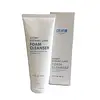What's inside
What's inside
 Key Ingredients
Key Ingredients

 Benefits
Benefits

 Concerns
Concerns

 Ingredients Side-by-side
Ingredients Side-by-side

Water
Skin ConditioningDecyl Glucoside
CleansingCocamidopropyl Betaine
CleansingPPG-26-Buteth-26
Skin ConditioningGlycerin
HumectantAcrylates/C10-30 Alkyl Acrylate Crosspolymer
Emulsion StabilisingPEG-40 Hydrogenated Castor Oil
EmulsifyingCoco-Glucoside
CleansingGlyceryl Oleate
EmollientPropylene Glycol
HumectantPotassium Hydroxide
BufferingChlorphenesin
AntimicrobialCitric Acid
BufferingAllantoin
Skin ConditioningPelargonium Graveolens Flower Oil
MaskingDisodium EDTA
Cetrimonium Bromide
AntimicrobialCitronellol
PerfumingGeraniol
PerfumingLinalool
PerfumingSodium Benzoate
MaskingCassia Angustifolia Seed Polysaccharide
Skin ConditioningHydrolyzed Algin
Phenoxyethanol
PreservativeHypericum Perforatum Extract
AntimicrobialMaris Aqua
HumectantAnthemis Nobilis Flower Extract
MaskingCalendula Officinalis Flower Extract
MaskingCentaurea Cyanus Flower Extract
AstringentChamomilla Recutita Flower Extract
MaskingTilia Cordata Flower Extract
Skin ConditioningHydroxyethylcellulose
Emulsion StabilisingChlorella Vulgaris Extract
Skin ConditioningWater, Decyl Glucoside, Cocamidopropyl Betaine, PPG-26-Buteth-26, Glycerin, Acrylates/C10-30 Alkyl Acrylate Crosspolymer, PEG-40 Hydrogenated Castor Oil, Coco-Glucoside, Glyceryl Oleate, Propylene Glycol, Potassium Hydroxide, Chlorphenesin, Citric Acid, Allantoin, Pelargonium Graveolens Flower Oil, Disodium EDTA, Cetrimonium Bromide, Citronellol, Geraniol, Linalool, Sodium Benzoate, Cassia Angustifolia Seed Polysaccharide, Hydrolyzed Algin, Phenoxyethanol, Hypericum Perforatum Extract, Maris Aqua, Anthemis Nobilis Flower Extract, Calendula Officinalis Flower Extract, Centaurea Cyanus Flower Extract, Chamomilla Recutita Flower Extract, Tilia Cordata Flower Extract, Hydroxyethylcellulose, Chlorella Vulgaris Extract
Glycerin
HumectantPotassium Myristate
EmulsifyingWater
Skin ConditioningButylene Glycol
HumectantPotassium Cocoyl Glycinate
Potassium Stearate
CleansingCocamidopropyl Betaine
CleansingMyristic Acid
CleansingSodium Methyl Cocoyl Taurate
CleansingPotassium Laurate
EmulsifyingPEG-40 Stearate
EmulsifyingLauric Acid
CleansingGlyceryl Stearate
EmollientPEG-100 Stearate
Parfum
MaskingStearic Acid
CleansingTocopheryl Acetate
AntioxidantCordyceps Sinensis Extract
AntioxidantPhellinus Linteus Extract
Skin ConditioningPhellinus Linteus/Rice Ferment Extract
EmollientPhellodendron Amurense Bark Extract
Skin ConditioningRheum Palmatum Root/Stalk Extract
AstringentScutellaria Baicalensis Root Extract
AstringentSophora Angustifolia Root Extract
Skin ConditioningAlthaea Officinalis Leaf/Root Extract
EmollientAnthemis Nobilis Flower Extract
MaskingFoeniculum Vulgare Leaf Extract
HumectantHouttuynia Cordata Extract
Skin ConditioningLavandula Angustifolia Flower
Skin ConditioningOcimum Basilicum Flower/Leaf Extract
TonicRosmarinus Officinalis Extract
AntimicrobialBeta-Glucan
Skin ConditioningTrisodium EDTA
Pyrus Malus Fruit Water
Masking1,2-Hexanediol
Skin ConditioningGlycerin, Potassium Myristate, Water, Butylene Glycol, Potassium Cocoyl Glycinate, Potassium Stearate, Cocamidopropyl Betaine, Myristic Acid, Sodium Methyl Cocoyl Taurate, Potassium Laurate, PEG-40 Stearate, Lauric Acid, Glyceryl Stearate, PEG-100 Stearate, Parfum, Stearic Acid, Tocopheryl Acetate, Cordyceps Sinensis Extract, Phellinus Linteus Extract, Phellinus Linteus/Rice Ferment Extract, Phellodendron Amurense Bark Extract, Rheum Palmatum Root/Stalk Extract, Scutellaria Baicalensis Root Extract, Sophora Angustifolia Root Extract, Althaea Officinalis Leaf/Root Extract, Anthemis Nobilis Flower Extract, Foeniculum Vulgare Leaf Extract, Houttuynia Cordata Extract, Lavandula Angustifolia Flower, Ocimum Basilicum Flower/Leaf Extract, Rosmarinus Officinalis Extract, Beta-Glucan, Trisodium EDTA, Pyrus Malus Fruit Water, 1,2-Hexanediol
 Reviews
Reviews

Ingredients Explained
These ingredients are found in both products.
Ingredients higher up in an ingredient list are typically present in a larger amount.
Anthemis Nobilis Flower Extract is from the Roman Chamomile flower. It helps soothe the skin and contains antioxidants.
Cocamidopropyl Betaine is a fatty acid created by mixing similar compounds in coconut oil and dimethylaminopropylamine, a compound with two amino groups.
This ingredient is a surfactant and cleanser. It helps gather the dirt, pollutants, and other impurities in your skin to be washed away. It also helps thicken a product and make the texture more creamy.
Being created from coconut oil means Cocamidopropyl Betaine is hydrating for the skin.
While Cocamidopropyl Betaine was believed to be an allergen, a study from 2012 disproved this. It found two compounds in unpure Cocamidopropyl Betaine to be the irritants: aminoamide and 3-dimethylaminopropylamine. High-grade and pure Cocamidopropyl Betaine did not induce allergic reactions during this study.
Learn more about Cocamidopropyl BetaineGlycerin is already naturally found in your skin. It helps moisturize and protect your skin.
A study from 2016 found glycerin to be more effective as a humectant than AHAs and hyaluronic acid.
As a humectant, it helps the skin stay hydrated by pulling moisture to your skin. The low molecular weight of glycerin allows it to pull moisture into the deeper layers of your skin.
Hydrated skin improves your skin barrier; Your skin barrier helps protect against irritants and bacteria.
Glycerin has also been found to have antimicrobial and antiviral properties. Due to these properties, glycerin is often used in wound and burn treatments.
In cosmetics, glycerin is usually derived from plants such as soybean or palm. However, it can also be sourced from animals, such as tallow or animal fat.
This ingredient is organic, colorless, odorless, and non-toxic.
Glycerin is the name for this ingredient in American English. British English uses Glycerol/Glycerine.
Learn more about GlycerinWater. It's the most common cosmetic ingredient of all. You'll usually see it at the top of ingredient lists, meaning that it makes up the largest part of the product.
So why is it so popular? Water most often acts as a solvent - this means that it helps dissolve other ingredients into the formulation.
You'll also recognize water as that liquid we all need to stay alive. If you see this, drink a glass of water. Stay hydrated!
Learn more about Water